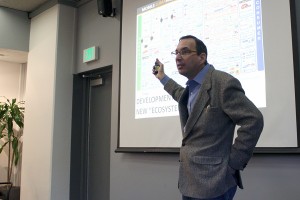Joseph Turow examines digital retail environments
The Annenberg School for Communication and Journalism hosted Joseph Turow, a professor from the Annenberg School for Communication at the University of Pennsylvania, for a talk on technology and retail stores on Monday afternoon.

Technological takeover · University of Pennsylvania professor Joseph Turow spoke about how in-store media has affected sales and revenues on Monday. – Jessica Zhou | Daily Trojan
Turow said there will be another wave of technology within the next decade that will make shopping at malls and grocery stores a more personalized experience for each user.
Turow discussed how appliances in stores that market messages to shoppers function as media. He gave the examples of coupon papers on the shelves of the grocery store and the televisions found on the ceiling of the local movie rental store that play trailers of movies, both in hopes of gaining the clients’ attention and influencing to make a purchase.
Turow said 40 percent of Facebook revenues now comes from mobile use, nine in 10 American adults now have a cell phone and 57 percent of adults own smartphones.
“Clearly mobile is an important media,” Turow said. “It is the most persuasive medium in the world. People sleep with their phones. People know their phones are lost more than their credit cards. And marketers really know this.”
Given this information, Turow explained that due to users’ constant consumption of information through mobile devices, many businesses are finding ways to make their retail experience more personalized.
Though in its beginning stages, there is an idea to produce an in-store tracking map of each person walking into a specific store via Wi-Fi and Bluetooth. Theoretically, Turow said consumers would connect their phones to the retail store, which would start their personalized experience.
Turow gave the example of a grocery store. Every time the person purchases a food item, it will supposedly register as data on that person’s account so that the next time the consumer shops at the grocery store, the marketers will show any coupons for the foods that the consumer has bought before.
Turow located problems within the system’s algorithms that start collecting personal data of each shopper.
He predicted that the collected data would create social hierarchies, which would encourage people to shop for goods at their socioeconomic “level.”
Turow used Neiman Marcus as an example of a store that could look at a consumer’s previous purchases and, using algorithms, judge if that consumer is someone who would be able to shop at Neiman Marcus.
“At that point, someone decided who you are — that is the problem,” said Ellen Helsper, an associate professor in media and communications at the London School of Economics and Political Science.
If this system were put in place, it would run the risk of preventing a person’s perceived identity from changing.
Turow argued that a business should split its square footage in half and use one of the spaces as a place to try clothes on and shop online, in order to transform the shopping experience into an easier system.
Turow said he believes that online shopping is gaining popularity, so a consumer could try on the clothing in the store and then order it online at his or her leisure.
“I can put on a medium coat, and then have it tomorrow,” Turow said of trying something on in a store and ordering it online.
Turow described businesses that are now advancing their in-store media to brand their retail even further, giving consumers a more powerful experience.
“In society, [two things are] really important in retail experience: touch and feel. [The] human experience is even now more important,” Helsper said.
Turow anticipated this transformation within retail shopping to happen in a decade, but says that the execution of the idea is still in the works.
“The programs are transforming the architecture of physical and digital retailing and the relationship between the two, in ways that make the selling environment increasingly dynamic and mutable for the individual prospect,” Turow said. “You are changing the store for the person walking through -— that’s the goal.”
Follow us on Twitter @dailytrojan
